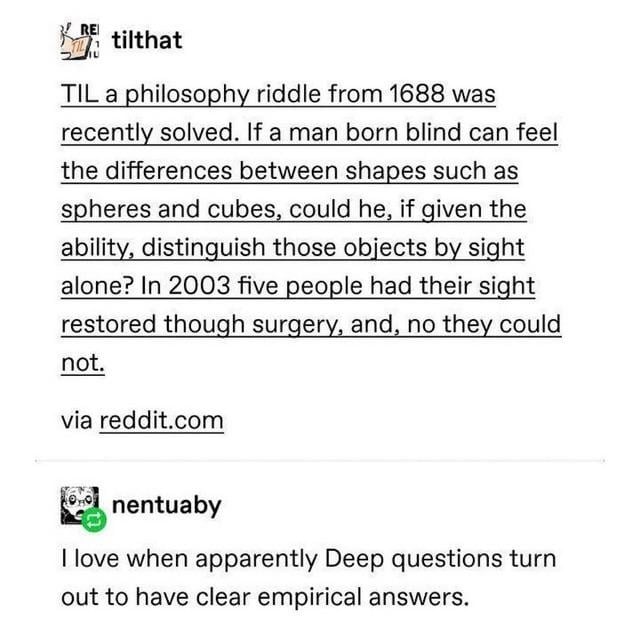this post was submitted on 21 Oct 2023
0 points (NaN% liked)
Microblog Memes
5392 readers
3249 users here now
A place to share screenshots of Microblog posts, whether from Mastodon, tumblr, ~~Twitter~~ X, KBin, Threads or elsewhere.
Created as an evolution of White People Twitter and other tweet-capture subreddits.
Rules:
- Please put at least one word relevant to the post in the post title.
- Be nice.
- No advertising, brand promotion or guerilla marketing.
- Posters are encouraged to link to the toot or tweet etc in the description of posts.
Related communities:
- !whitepeopletwitter@sh.itjust.works
- !best_of_mastodon@sh.itjust.works
- !curatedtwitter@sh.itjust.works
- !curatedtumblr@sh.itjust.works
founded 1 year ago
MODERATORS
you are viewing a single comment's thread
view the rest of the comments
view the rest of the comments

... they really can't connect spacial awareness from touch to sight? Really?
Skill issue
Literally.
I could imagine it being difficult to conceptualize without the ability to visualize, but yeah, I find it hard to believe, too. Between cube and sphere, at the very least, I'd expect them to realize the pointy bits are probably the corners of the cube, not a flat surface.
How do you expect them to know what pointy bits even look like?
I don't expect them to know. I'm saying, if they're given time to think about it, I'd expect them to make an educated guess that's likely correct.
Pointy bits feel thin, unlike the rest of these shapes. So, if they're given only the sphere and the cube to feel, they could remember that the cube had 8 pointy bits, the sphere did not.
Of course, a lot depends on how these tests were performed and what "they could not" actually means.
You're still assuming an ability to connect shapes to vision, even if what you're assuming is the most basic connection. Keep in mind these people had absolutely nothing to base their visual experiences on. I'm sure that given a few minutes to play with the objects they'd begin to map their visual inputs to mental models, but at first, it'll all look like abstract garbage
It's not that they don't have a sort of 3d model of a cube in their mind, it's that their 3d model of a cube includes absolutely nothing visual, which is virtually impossible for us to even imagine
I actually felt like my pointy bits method was entirely disconnected from experience. Yeah, they see abstract garbage, but they'll still see anomalies in this abstract garbage. And they were able to feel anomalies on the cube.
It does take some thinking to make a guess like that. And they may have still been completely overwhelmed with sight in general. And again, I don't know what the methodology in these tests looked like. But yeah, just summarizing it as "they could not" seems entirely unhelpful.
What does a pointy bit look like to someone who has never seen one ? You have years of experience matching your visual input of the world around you with your tactile experiences, it's easy to forgot how much of our basic knowledge is learned at a young age.
Sure, as I said, without the ability to visualize, this may be tricky. But I'm imagining this test as them being given enough time to think about it and feel the shapes and maybe even count the pointy bits. At the very least, I'd expect an educated guess that's likely correct, if they're only discerning sphere and cube. Of course, a lot depends on how these tests were performed.